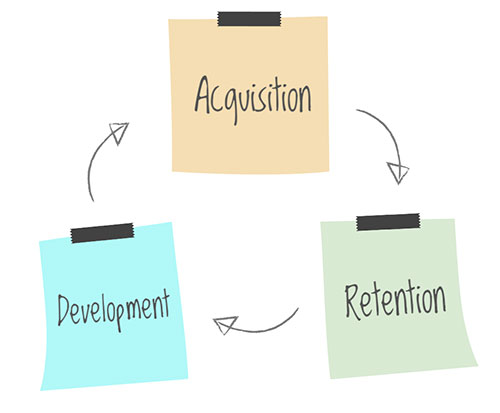
Understanding Customer Relationships: Part 1
For someone who owns a small business or multiple projects, you would need to know all about your customers, how they behave, what they need, and how you can give that to them — especially in a progressively customer-centric digital world like the present. You don’t only want to know about your customers, but how to build relationships with them, and how to make those relationships valuable for both the customers and the business.
In comes Customer Relationship Management, which you may have only heard of as a software for businesses, but there is much, much more to it than that.
What is CRM?
Customer Relationship Management (CRM) is an approach to managing an organisation’s interactions with its current and future customers.
The Customer Relationship Lifecycle
Acquisition — attracting new customers
Retention — keeping a high proportion of current customers (by reducing customer defections)
Development — increasing the value of retained customers to the company
Or possibly, termination. More about this lifecycle in Part 2.
Components of CRM
There are various aspects of CRM that can benefit businesses in different ways:
- Strategic — a customer-centric business strategy that aims at winning and keeping profitable customers
- Operational — focuses on the automation of customer-facing processes such as sales, marketing, and service
- Analytical — focuses on data mining of customer-related data for strategic purposes
- Collaborative — applies technology across organisational boundaries to encourage and improve data collaboration, with a view to optimise company, partner, and customer value
Relationships
Our daily lives consist of many types of relationships, from family and friends, to colleagues, partners, and peers. A relationship is composed of a series of interactive episodes between parties over time. Relationships are dynamic, not static but evolving over time; ever-changing.
Theories of Relationships
As you may be aware, we all have different relationships for different reasons; you don’t want to be romantically intimate with Woolies, or trying to make money off of your girlfriend… These theories of relationships are what we can use to understand the various types of relationships:
- Adaptation — form relationships for one’s survival and successful reproduction/evolution
- Validation — form relationships for the reinforcements that we receive
- Social Exchange — form relationships to maximise rewards and minimise costs
- Equity — form relationships with emphasis on fairness; “give what you get”
- Investment — form relationships based on satisfaction, investment made, and assessment of alternatives
In order to fully understand which theory of relationships to best apply to which type of relationship, one must fully understand the motivations that undermine the formation of relationships, particularly for customer-organisation relationships.
Customer Relationship Motivations
Motivations for customers to form relationships vary across many different factors, such as relationship types, product/service categories, and customer segments. But not all customers seek relationships.
- Recognition — customers may feel more valued when they are recognised, and are more familiar to the seller
- Personalisation — customers can feel more comfortable when products/services are catered to their personal needs and are customisable
- Risk Reduction — reduced perceived risks is an attractive feature for forming relationships
- Status — customer status is enhanced by a relationship with a business
- Affiliation — people’s social needs can be met by forming a relationship with a business
Attributes of relationships
As customer relationships go through the various stages of development, there are a few attributes and characteristics that can change with it. Two main relationship attributes are indicators of the level and nature of developed customer relationships:
- Trust
Trust emerges as parties share experiences and interpret and assess each other’s motives. It includes: benevolence, honesty, and competence. - Commitment
Commitment is the belief that the relationship is worth investing in to make it endure. It arises from trust, where customers choose more stable, long-term benefits associated with businesses, over short-term ones. The three types of commitment are:- Instrumental — customers convinced that no other company will do a better job
- Relational — customers develop an emotional tie to the other party
- Values-based — customers’ values are aligned with those of the company
Value
CRM seeks to create and deliver value for customers, so as to provide deliver for the organisation as well, but not all customers define value the same way. This can differ because of age, taste, gender, etc. There are four general meanings of value:
- Value is low price
- Value is getting what you want from a product or service
- Value is the quality you get for the price you pay
- Value is all you get for all you sacrifice

